How safe is Italy's high-speed rail network?
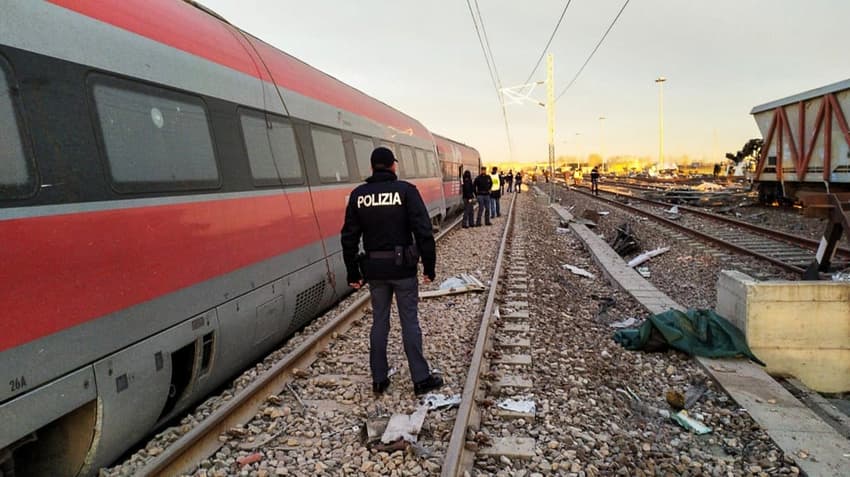
After a high-speed train derailed near Milan on Thursday morning, killing two railway workers and leaving dozens of passengers injured, many people are now thinking twice about their planned rail journeys in Italy. But how high is the risk really?
The derailed train was a FrecciaRossa, one of the high-speed trains run by Italian national operator TrenItalia, used by millions of passengers every year to zip between Italy's major cities.
The crash happened at Lodi, 50 kilometres from Milan - a hub for Italy's high-speed rail network.
While it's not yet known what caused the train to derail, such incidents are thankfully rare.
But as rail workers' unions demand answers and a police investigaton continues, the incident has sparked accusations that Italy's aging high-speed lines are becoming unsafe.
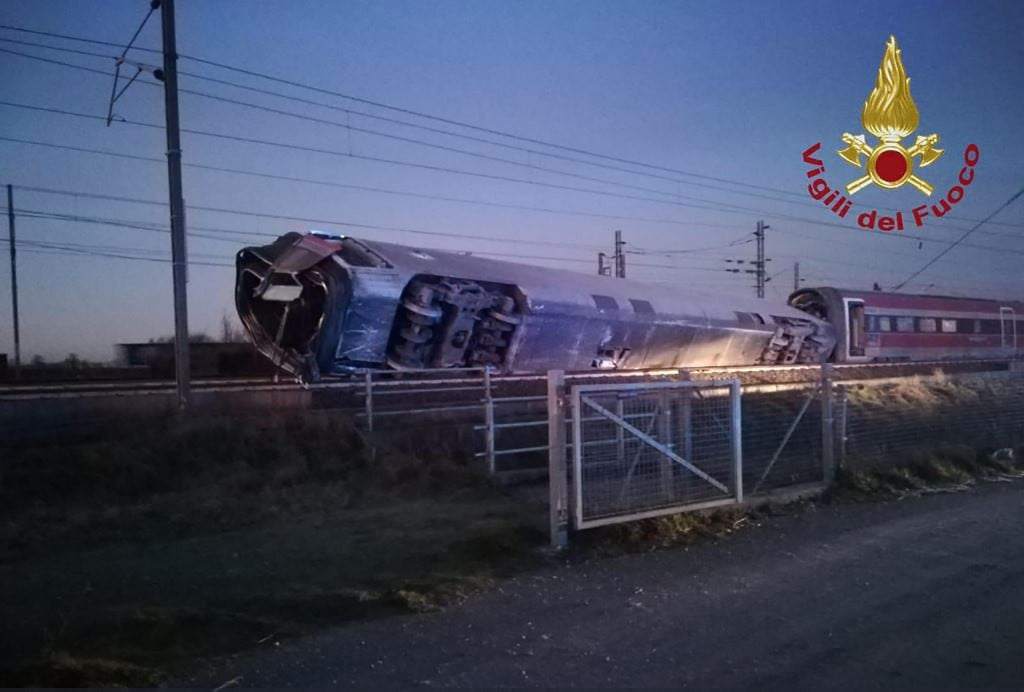 The derailed engine at Lodi on Thursday. Photo: Vigili del Fuoco/AFP
Italy's last serious rail accident occurred in May 2018, when a train hit a truck that was stuck on a level crossing near Turin. Two people died, including the train driver, and more than 20 were injured. This was a regional, not high-speed, train.
Ad in January 2018, three women died and about 100 passengers were injured when a packed train derailed near Milan due to poor track maintenance.
Following that accident, managers and employees of Italy's state railway, RFI, as well as two former members of the national railway safety agency were charged with negligent homicide and other crimes.
Before that, in 2016, 23 people died in a head-on collision between two trains in the southern Italian region of Puglia.
Such disasters are thankfully rare. And these did not involve high-speed trains like the one which derailed in Lodi.
However, some commentators in Italy are now questioning whether parts of Italy's high-speed rail network are fit for purpose.
While these lines only cover part of the country, and there are big plans to extend the high-speed lines beyond the biggest cities, some say the busier lines on the network now get too much traffic.
The derailed engine at Lodi on Thursday. Photo: Vigili del Fuoco/AFP
Italy's last serious rail accident occurred in May 2018, when a train hit a truck that was stuck on a level crossing near Turin. Two people died, including the train driver, and more than 20 were injured. This was a regional, not high-speed, train.
Ad in January 2018, three women died and about 100 passengers were injured when a packed train derailed near Milan due to poor track maintenance.
Following that accident, managers and employees of Italy's state railway, RFI, as well as two former members of the national railway safety agency were charged with negligent homicide and other crimes.
Before that, in 2016, 23 people died in a head-on collision between two trains in the southern Italian region of Puglia.
Such disasters are thankfully rare. And these did not involve high-speed trains like the one which derailed in Lodi.
However, some commentators in Italy are now questioning whether parts of Italy's high-speed rail network are fit for purpose.
While these lines only cover part of the country, and there are big plans to extend the high-speed lines beyond the biggest cities, some say the busier lines on the network now get too much traffic.
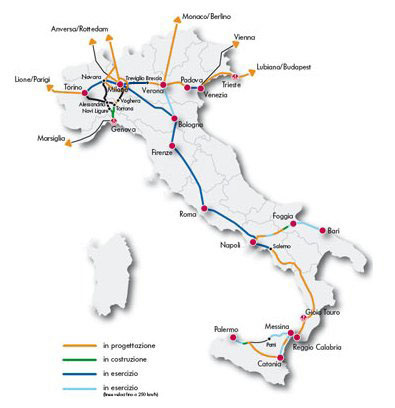 Existing and planned sections of Italy's high-speed rail network.Map: Rete Ferrovia Italiana
Existing and planned sections of Italy's high-speed rail network.Map: Rete Ferrovia Italiana
The investigation into the cause of the Lodi crash is still ongoing and there has been no official explanation for the tragedy yet. But prosecutors investigating the derailment say it is likely to have been caused by "human error".
Points on the track were reportedly left in the wrong position, though the technicians who had carried out maintenence work on that stretch of track earlier in the day denied any wrongdoing, La Repubblica reports.
"We left it in the normal position, we can't explain ourselves," the technicaions told investigators.
The Lodi accident hs highlighted problems on the especially busy stretch of line between Milan and Rome, where a train reportedly runs every 12 minutes in each direction, La Repubblica writes.
The short time between trains reportedly leaves the network vulnerable - the slightest problem or delay can cause knock-on delays right across the high-speed network.
And the shorter the intervals, the more stressed the network becomes and the more maintenance required. It also leaves less time for maintenance works to be carried out, La Repubblica writes.
Italian railworkers’ trade unions are demanding answers and say they've “lost faith” in existing safety procedures on the line.
“We have to reassess everything,” Italian Federation of Transport Workers’ union spokesman Giovanni Abimelech stated the day after the accident.
“If there is human error it means that things are not going well. One more step is needed for confirmation. Because this mustn’t happen again,” he said. “As of yesterday we lost a little faith in the fact that the trains are safe.”
Italy was the first European country to start building a high-speed rail line in the 1970s - meaning some of the infrastructure is now aging.
Today the oldest stretch of high-speed track ,between Rome and Florence, faces limitations. While Italy's high-speed trains usually travel at 300 kilometres per hour, they have to slow down to 250 km/h on this aging secton.
While it may not be as high-speed a sit once was, however, there is no evidence that Italy's high speed lines are especially dangerous for passengers.
The number of "significant" railway accidents in Italy overall is below the European average, according to data from Italy's National Railway Safety Agency (ANSF).
According to the latest ANSF data available, from the period 2008-2014, there were an average of 13 train crashes and derailments in Italy per year. This was a decrease on the previous period (2004-2007) in which the number was 16.
The majority of serious accidents on Italy's railways were found to be those occurring at level crossings, and most of the victims were people on the tracks. Staff and passengers on board the trains made up less than ten percent of victims in railway accidents annually.
And while Denmark, the UK and the Netherlands lead Europe when it comes to railway safety, the figures show Italy is not a particularly dangerous place to board a train.
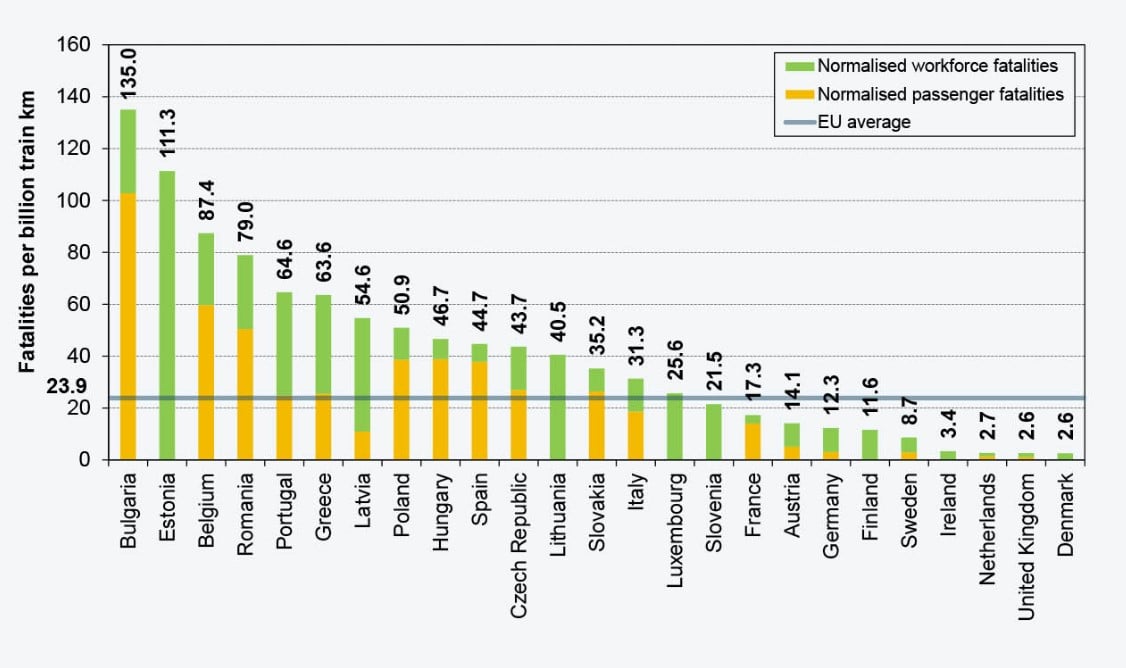
Comparison of Passenger and Workforce Fatality Rates Across Europe.Source: ORR, 2013.
READ ALSO: Everything you need to know about train travel in Italy
In Italy as elsewhere in Europe, rail remains the safest form of overland transport, according to the European Commission.
As for other dangers, a more common risk passengers face is that of potential theft and pickpocketing - though this is not seen as a major issue either. High-speed trains in particular are thought to be safer in this regard.
All trains in Italy are generally busy, well staffed, and well lit. The areas around some train stations may be risky, particularly late at night, but it's enough to take the same basic safety precautions you would anywhere else.
The biggest (but still not very big) risk is having a bag stolen. Trenitalia says it's the passenger's responsibility to keep an eye on luggage, even if it's stowed at the end of the train car. There is, however, insurance against bag theft that applies to most Trenitalia passengers.
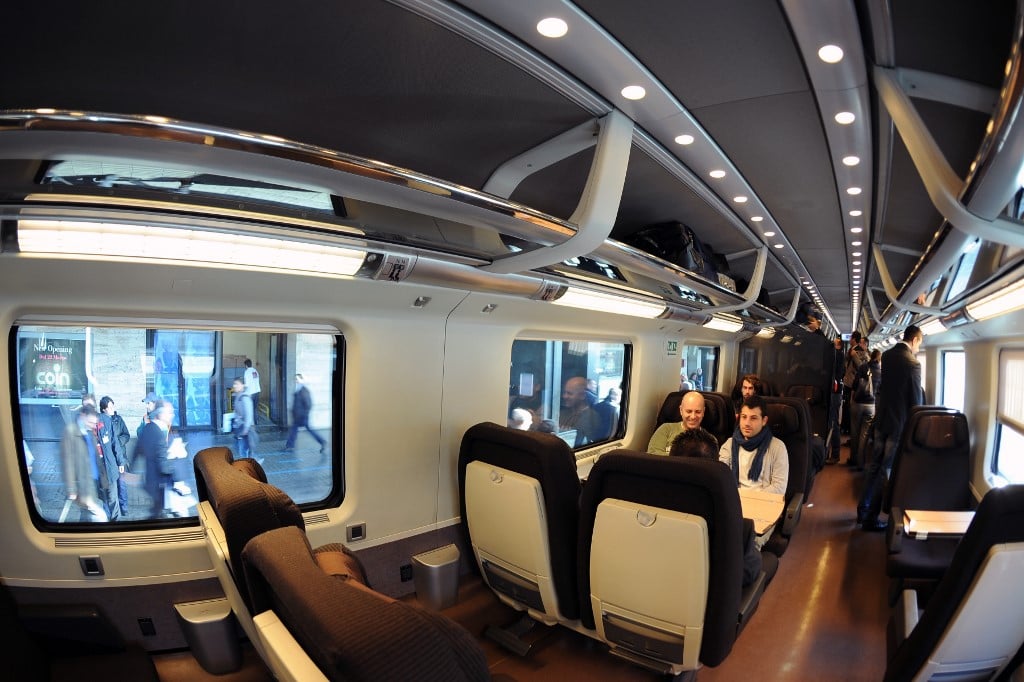 On board a FrecciaRossa train at Rome's Termini station. Photo: AFP
On board a FrecciaRossa train at Rome's Termini station. Photo: AFP
Comments
See Also


The investigation into the cause of the Lodi crash is still ongoing and there has been no official explanation for the tragedy yet. But prosecutors investigating the derailment say it is likely to have been caused by "human error".
Points on the track were reportedly left in the wrong position, though the technicians who had carried out maintenence work on that stretch of track earlier in the day denied any wrongdoing, La Repubblica reports.
"We left it in the normal position, we can't explain ourselves," the technicaions told investigators.
The Lodi accident hs highlighted problems on the especially busy stretch of line between Milan and Rome, where a train reportedly runs every 12 minutes in each direction, La Repubblica writes.
The short time between trains reportedly leaves the network vulnerable - the slightest problem or delay can cause knock-on delays right across the high-speed network.
And the shorter the intervals, the more stressed the network becomes and the more maintenance required. It also leaves less time for maintenance works to be carried out, La Repubblica writes.
Italian railworkers’ trade unions are demanding answers and say they've “lost faith” in existing safety procedures on the line.
“We have to reassess everything,” Italian Federation of Transport Workers’ union spokesman Giovanni Abimelech stated the day after the accident.
“If there is human error it means that things are not going well. One more step is needed for confirmation. Because this mustn’t happen again,” he said. “As of yesterday we lost a little faith in the fact that the trains are safe.”
Italy was the first European country to start building a high-speed rail line in the 1970s - meaning some of the infrastructure is now aging.
Today the oldest stretch of high-speed track ,between Rome and Florence, faces limitations. While Italy's high-speed trains usually travel at 300 kilometres per hour, they have to slow down to 250 km/h on this aging secton.
While it may not be as high-speed a sit once was, however, there is no evidence that Italy's high speed lines are especially dangerous for passengers.
According to the latest ANSF data available, from the period 2008-2014, there were an average of 13 train crashes and derailments in Italy per year. This was a decrease on the previous period (2004-2007) in which the number was 16.
The majority of serious accidents on Italy's railways were found to be those occurring at level crossings, and most of the victims were people on the tracks. Staff and passengers on board the trains made up less than ten percent of victims in railway accidents annually.
And while Denmark, the UK and the Netherlands lead Europe when it comes to railway safety, the figures show Italy is not a particularly dangerous place to board a train.

Comparison of Passenger and Workforce Fatality Rates Across Europe.Source: ORR, 2013.
READ ALSO: Everything you need to know about train travel in Italy
In Italy as elsewhere in Europe, rail remains the safest form of overland transport, according to the European Commission.
As for other dangers, a more common risk passengers face is that of potential theft and pickpocketing - though this is not seen as a major issue either. High-speed trains in particular are thought to be safer in this regard.

Join the conversation in our comments section below. Share your own views and experience and if you have a question or suggestion for our journalists then email us at [email protected].
Please keep comments civil, constructive and on topic – and make sure to read our terms of use before getting involved.
Please log in here to leave a comment.